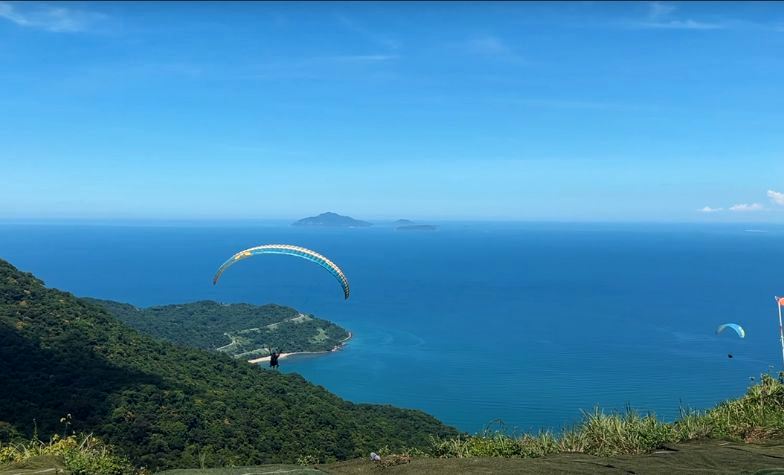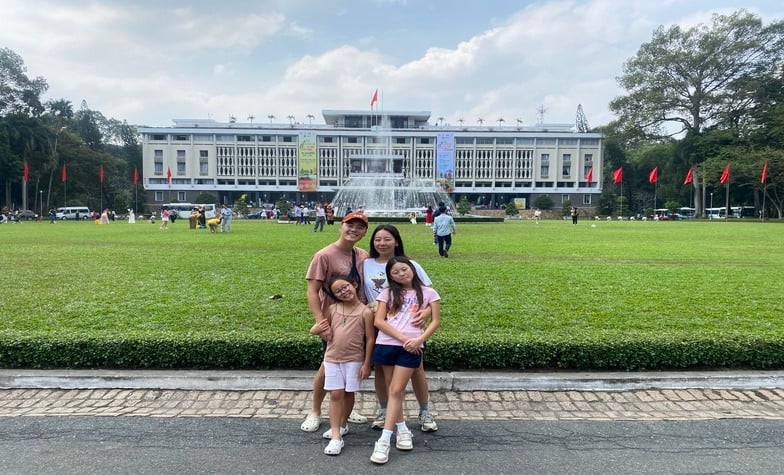

Wondering what Vietnam feels like in February? From misty mountains in the north to sunny beaches in the south, the country offers a fascinating blend of climates. Whether you're chasing spring blossoms in Hanoi or basking in sunshine in Phu Quoc, this guide to Vietnam weather in February will help you plan the perfect trip!
Northern Vietnam in February still carries the chilly atmosphere of winter, blended with the gentle warmth of early spring. Average temperatures range from 13–20°C, with cold nights and slightly warmer days when the sun is out. The air is humid, and light drizzles or morning fog are common - creating a misty, romantic charm in destinations like Hanoi, Ninh Binh, and Sapa. However, the weather is often gloomy and damp, so travelers should pack warm jackets, anti-slip shoes, and a small umbrella for added comfort.
Central Vietnam enjoys more pleasant weather in February as it transitions from winter to spring. With average temperatures from 18–26°C, the region experiences dry, mild days and moderate humidity. Cities like Hue, Da Nang, and Hoi An typically enjoy clear skies and sunshine, perfect for strolling ancient towns, visiting historical sites, or joining vibrant local festivals. That said, the northern part of Central Vietnam may still feel a bit chilly in the mornings and evenings due to lingering northeastern monsoon winds. A light jacket and comfortable footwear will go a long way.
Southern Vietnam enters its best season of the year - dry, sunny, and refreshingly comfortable. With low humidity and average temperatures between 24–33°C, it’s ideal for outdoor adventures like exploring the Mekong Delta, visiting floating markets, or enjoying beach days in Vung Tau, Mui Ne, or Phu Quoc. The festive spirit of Tet (Lunar New Year), which often falls in February, adds a vibrant touch with blooming flowers and colorful celebrations. Just bring a hat, sunscreen, and light clothing - and you’re all set for an unforgettable journey.
|
Location |
Average Temperature in ºC(ºF) |
Average Precipitation in mm (inch) |
|
Dien Bien Phu |
18.0 (64.4) |
31 (1.2) |
|
Sa Pa |
10.3 (50.5) |
81 (3.2) |
|
Yen Bai |
16.8 (62.2) |
45 (1.8) |
|
Cao Bang |
15.1 (59.2) |
25 (0.98) |
|
Ha Long Bay |
16.6 (61.9) |
25 (0.98) |
|
Ha Giang |
16.9 (62.4) |
42 (1.7) |
|
Hanoi |
17.2 (63.0) |
19 (0.75) |
|
Vinh |
17.9 (64.2) |
42 (1.7) |
|
Hue |
20.7 (69.3) |
65 (2.6) |
|
Quang Ngai |
22.4 (72.3) |
41 (1.6) |
|
Da Lat |
16.9 (62.4) |
21 (0.83) |
|
Central Highland |
22.4 (72.3) |
5 (0.20) |
|
Pleiku |
20.5 (68.9) |
6 (0.24) |
|
Ho Chi Minh City |
26.8 (80.2) |
4 (0.16) |
|
Vung Tau |
25.4 (77.7) |
0 (0) |
|
Can Tho |
25.9 (78.6) |
2 (0.079) |
|
Phu Quoc Island |
26.5 (79.7) |
29 (1.1) |
Hanoi: February marks the arrival of spring in Hanoi, with a light chill in the air, occasional drizzle, and a veil of mist. It’s a perfect time to soak up the city’s poetic charm and timeless atmosphere. Wander around Hoan Kiem Lake, visit the Temple of Literature, sip hot tea by the street, or enjoy a steaming bowl of pho. Tet (Lunar New Year) celebrations linger, filling the streets with peach blossoms, kumquat trees, and vibrant red decorations - a beautiful blend of tradition and festivity.
Sapa: Still chilly in February—with nighttime temperatures dropping below 10°C - Sapa enjoys sunny, clear days. This is the season of blooming plum and peach blossoms across terraced fields and hillsides. It’s an ideal time for trekking through ethnic villages like Cat Cat and Ta Van, staying in homestays, trying traditional herbal baths, and admiring the majestic northwest mountains. The fresh air and picturesque scenery make Sapa a February favorite.
Ninh Binh: With cool, pleasant weather (around 16–22°C), February is perfect for exploring the outdoors in Ninh Binh. Glide through the stunning karst landscapes of Trang An by boat, hike up Hang Mua, or visit the ancient temples of King Dinh and King Le. Don’t miss Bai Dinh Pagoda, which hosts one of the largest spring festivals in the north. A mix of natural beauty, fresh air, and lively cultural events makes Ninh Binh an unforgettable stop.
Hoi An: February is an ideal time to visit Hoi An, with sunny skies, little rain, and temperatures between 20–26°C. The ancient town is dressed in spring colors, lanterns, and festive charm. Stroll along the stone-paved streets, enjoy cao lau noodles, release flower lanterns on the Hoai River, or visit craft villages like Thanh Ha pottery. The mild weather makes it easy to explore from dawn to dusk without feeling tired.

Da Nang: This coastal city enjoys dry, cool weather in February, with temperatures around 20–27°C—perfect for both relaxation and adventure. Unwind on My Khe Beach, take the cable car to Ba Na Hills to experience “four seasons in a day,” or explore Marble Mountains and Son Tra Peninsula. Calm seas, gentle sunshine, and scenic beauty make Da Nang a delightful destination for early-year trips.
Da Lat: February transforms Da Lat into a floral wonderland with blooming cherry blossoms, mimosa, and sunflowers. The weather is crisp and sunny, with daytime temperatures between 18–24°C—perfect for visiting tea hills, Tuyen Lam Lake, the Valley of Love, or simply sipping coffee in a quiet café. The romantic vibe and cool climate make Da Lat a top pick for couples and nature lovers.
Phu Quoc: February is peak dry season in Phu Quoc, offering clear skies, calm seas, and endless sunshine. With average temperatures of 26–32°C, it’s ideal for swimming, snorkeling, island hopping, or unwinding at a beachfront resort. Don’t miss night squid fishing, fresh seafood feasts, and browsing the bustling Dinh Cau night market. The stunning weather makes Phu Quoc a dream island escape this time of year.
Can Tho: February brings perfect weather to Can Tho - sunny, dry, and low humidity - making it ideal for exploring the Mekong Delta. Wake up early for the Cai Rang floating market, visit fruit orchards and the historic Binh Thuy Ancient House, or immerse yourself in the laid-back riverside lifestyle. Early spring is also fruit-blossom season, adding natural beauty to this cultural and culinary journey through Vietnam’s southwest.
February is a vibrant festival season in Vietnam, filled with meaningful spiritual events. The Perfume Pagoda Festival in Hanoi kicks off on the 6th day of the Lunar New Year, featuring scenic boat rides on the Yen Stream and pilgrimages to Huong Tich Cave. The Yen Tu Festival (Quang Ninh), starting on the 10th day of the Lunar New Year, invites visitors to explore the sacred Buddhist site of Yen Tu Mountain. Meanwhile, the Tran Temple Festival (Nam Dinh), held on the night of the 14th day, captivates pilgrims with the solemn "seal-opening" ceremony to pray for success and prosperity.
Adding to the festive spirit, February also brings a splash of modern color and creativity. The Da Lat Flower Festival, usually held early in the year, transforms the city with vibrant floral displays and lively street performances. In Ho Chi Minh City, the Book Street Festival and Light Festival turn Nguyen Hue Walking Street into a buzzing hub of culture and entertainment. Cities like Da Nang and Nha Trang also host outdoor music and light festivals, attracting young travelers eager to celebrate spring in a fun, energetic, and colorful way.
Check the regional weather: February weather differs significantly across Vietnam. The north is cold with light drizzle, the central region is mild and sunny, while the south is warm and dry. Understanding this helps you pack the right clothes for each destination.
Pack versatile clothing: Bring warm jackets and layers if you’re heading to the north or Sapa, and light, breathable outfits for the south. Don’t forget essentials like sneakers, a light raincoat, sunglasses, and sunscreen.
Plan early – avoid Tet travel rush: If your trip coincides with the Lunar New Year (Tet), book flights and hotels well in advance as prices rise and many places fill up quickly. Some businesses may close during the holiday period.
Experience traditional festivals: Early in the year is festival season throughout Vietnam. Join in to discover vibrant local culture, but be cautious in crowded places and keep your belongings safe.

Taste Tet specialties: February is the perfect time to try seasonal Vietnamese treats like banh chung (sticky rice cake), gio lua (pork sausage), mut Tet (candied fruits), pickled vegetables, and sweet glutinous rice balls.
Bring a camera or keep your phone charged: Springtime in Vietnam is filled with visual beauty—from blooming peach blossoms in the north to colorful festivals and lanterns throughout the country. Don’t miss the chance to capture these moments.
Connect with locals: During Tet, Vietnamese people are especially friendly and open. A warm smile or a simple “Chuc mung nam moi” (Happy New Year) can lead to memorable encounters and deeper cultural experiences.
Vietnam in February offers the perfect mix of mild weather, festive vibes, and stunning landscapes from north to south. Whether you're into cultural journeys or beach escapes, this is an ideal time to explore. Now that you know what to expect from Vietnam weather in February, it’s time to pack your bags and turn your travel dreams into reality!
| Excellent | |||
| Good | |||
| Average | |||
| Poor |
Ba Be Lake | |
Bac Ha | |
Bach Ma NP | |
Ban Gioc Waterfall | |
Buon Ma Thuot | |
Can tho | |
Cao Bang | |
Cat Ba Island | |
Chau Doc | |
Con Dao Island | |
Cu Chi Tunnel | |
Da Lat | |
Da Nang | |
Dien Bien Phu | |
Dong Van | |
Former DMZ | |
Ha Giang | |
Ha Long Bay | |
Hanoi | |
Ho Chi Minh City | |
Hoa Lu ancient capital | |
Hoang Su Phi | |
Hoi An | |
Hue | |
Lai Chau | |
Lang son | |
Mai Chau | |
Mu Cang Chai | |
Mui Ne | |
My Son Holyland | |
My Tho | |
Nha Trang | |
Ninh Binh | |
Phong Nha Ke Bang NP | |
Phu Quoc Island | |
Pleiku | |
Pu Luong | |
Quy Nhon | |
Sapa | |
Son La | |
Tam Coc | |
Vung Tau |
| Laos | Cambodia | Thailand |
| Myanmar | Indonesia | |
| Singapore | Malaysia | |
| Philippine | ||